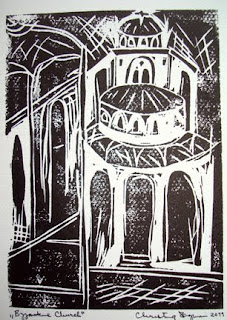 I have never painted an Eastern Orthodox-style Icon. . . it would seem to me blasphemous to paint Icons without proper study and deeper knowledge of traditional Orthodox symbolism. However, I often mention the impact that Iconography has had on my paintings (particularly the Icons of Elias Katsaros that I have admired for hours during services at a small Greek Orthodox church in Huntsville, and also many much older Icons that I have been fortunate to see). In the suburbs of Montreal, there was a Greek living near some of my cousins who painted Icons in his garage, which he had converted into a studio; he would open up the garage door on pleasant days, revealing the brightly-colored blocks of imagery hanging from floor to ceiling, and sit outside on his driveway working on new ones. . . I wondered whether he was painting them for churches or whether it was simply a private hobby; I still wonder about what it would take to become a serious iconographer.
I have never painted an Eastern Orthodox-style Icon. . . it would seem to me blasphemous to paint Icons without proper study and deeper knowledge of traditional Orthodox symbolism. However, I often mention the impact that Iconography has had on my paintings (particularly the Icons of Elias Katsaros that I have admired for hours during services at a small Greek Orthodox church in Huntsville, and also many much older Icons that I have been fortunate to see). In the suburbs of Montreal, there was a Greek living near some of my cousins who painted Icons in his garage, which he had converted into a studio; he would open up the garage door on pleasant days, revealing the brightly-colored blocks of imagery hanging from floor to ceiling, and sit outside on his driveway working on new ones. . . I wondered whether he was painting them for churches or whether it was simply a private hobby; I still wonder about what it would take to become a serious iconographer.At any rate, the geometry and stylization of these images have always been aesthetically appealing to me, but more importantly, I have long been fascinated by the ancient concept of the image as a window to the spirit of a person or place and its evolution over time, as well as the way in which certain forms of abstraction and stylization deliberately reject materialism while stressing the universal. It is not surprising, then, that I would be so drawn to the work of Wassily Kandinsky, an Orthodox Christian from Russia, who also marveled at Icons and the religious glass paintings he saw in Bavaria (he made many glass paintings of his own, in fact).
My most recent block print [above, Byzantine Church] was created with these thoughts in mind, the design having been inspired by the architecture in the background of a 14th Century Greek Icon. It is not meant to be an Icon, rather, it is a small way of expressing artistic gratitude to a tradition that has influenced my outlook so deeply.
No comments
Post a Comment